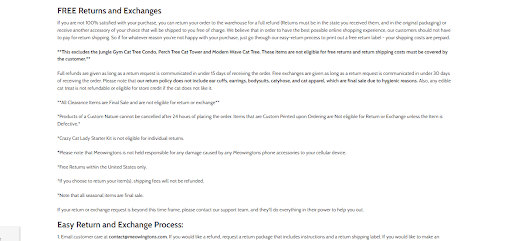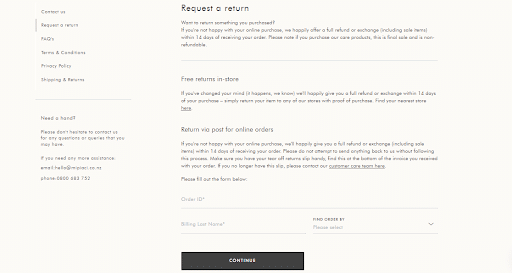How to Handle Dropshipping Returns & Refunds
Contents

Dropshipping returns are one unavoidable nightmare you will confront when running a dropshipping business.

Not only will you lose sales, but you will also feel as though your efforts have gone to waste. Plus, you will have to appease angry customers who might ruin the reputation of your business if you don’t sort out their return and refund requests.
That being said, handling dropshipping returns doesn’t have to be a nightmarish experience. In fact, handling refund and return requests promptly and professionally can help boost the reputation of your business.
In this post, you will learn about dropshipping returns and why they are a big deal. Also, you will get to see what return policies are and why having one in place is very important.
Most importantly, we will show you the process for handling returns and share best practices for setting up a return policy.
Stick around!


What is a Return Policy?
It’s important to have a solid return policy in place before setting up your website. What is a return policy, you might be wondering?
As the name suggests, a return policy is a set of guidelines that dictate how customers can return products or request a refund after buying from your store.
It spells out the criteria customers ought to meet to qualify for a free return.
Here is an example from Meowintons.

For example, it tells customers the timeframe within which they can return a defective/unwanted product after making a purchase. It can be a 30-day, 40-day, or 50-day timeframe.
Also, it can spell out the category of products that qualify for a return and if they can return products for free.
Why do you need one?
Why Are Return Policies Important for Dropshippers?
A transparent, customer-centric return policy makes it easy to build trust and loyalty with your customers. In fact, it can actually help to boost your sales.
Sounds weird, right? How can something that hurts your sales still help to boost it?
Let’s explain.
When your customers know they can always return products without any hassles, they will naturally be inclined to buy more from your store.
When they know that you will attend to their refund request in a timely and professional manner, they will readily recommend your store to their friends. That’s free PR!
Most importantly, having a return and refund policy ensures your dropshipping business runs smoothly without hitches.
Also, keep in mind that returns are an unavoidable part of running a shop – online or offline. If you doubt us, here are stats that will make you have a rethink:
- 30% of products bought online get returned.
- 88% of shoppers say they want to be able to return a product with ease, and this will make them want to buy from a store repeatedly.
- 54% of shoppers say they will likely not buy from a retailer with an unclear, vague return policy.
- 92% of buyers say they will buy again from a store with an easy return policy.
And numbers don’t lie.
If you want to build a good reputation for your dropshipping business and win your customers’ trust, you must take return policies seriously.
Understanding the Dropshipping Return Process
It’s important to understand how a typical dropshipping return process works before putting up a return policy on your website.
In this section, we will run you through a dropshipping return process. But, before that, we want to share common reasons why shoppers return their purchases.
They include:
Defective products: This is one of the common reasons buyers return purchased items. You have to act promptly whenever a customer requests to return a defective item. And they should be able to do so without paying.
But how do you know if the item was already damaged before it got to them? Ask for a video or a picture as proof.
Size Mismatch: This frequently happens with clothes and footwear. A customer orders a shirt and tries it on, only to discover it is oversized. Another customer buys a shoe, wears it, and finds out they are smaller than her legs.
Size mismatch errors happen for several reasons. It could be that you wrongly listed the wrong size on your website.
The fault can also come from the supplier. Other times, it can be that the customer made a mistake with size.
Either way, you still have to handle return requests professionally.
Wrong order: A customer orders a shoe only to get a slipper. Or orders a shirt but gets something entirely different.
It happens. It might not be your fault, but you need to attend to such return requests whenever they come in.
That being said, here are the stages of a product return process:
Stage 1: A customer initiates a return request
A return process starts when a customer initiates one. Depending on your setup, they can do this by emailing you directly or contacting customer support if you have one.
Alternatively, you can create a request for a return form on your website, just as Mi Piaci does.

Be sure to send an email to the customer acknowledging the receipt of their return request and apologizing for the inconvenience. Also, let them know you will take prompt action.
Stage 2: Receive the product in question
After initiating a return request, the next logical thing to do is to ask the aggrieved customer to send over the faulty product.
But wouldn’t it be wise if they sent it directly to your supplier since you don’t keep any inventory?
Well, there are many reasons why you will want to receive the product first before sending it to your supplier.
Firstly, you will want to inspect the product to ensure that the damage was from the supplier and not the customer. Also, it can make the return process a lot smoother.
Stage 3: Send the product back to the supplier
After receiving the defective product from your customer, the next step is to contact your supplier to return the product.
But before that, you have to determine if the cost of shipping the product back to your supplier is worth it.
For example, if a customer returns a $25 shirt that will cost you $50 to return, that won’t work. In such a case, the best thing to do is offer the customer a replacement.
Notwithstanding, if returning the product makes sense, request an RMA (Return Merchandize Authorization) number from your supplier and ship the product back.
Stage 4: Supplier sends a replacement or a refund
After receiving your RMA, most suppliers will instantly approve and give you a refund or a replacement, depending on their return policy.
Once you receive it, send it to your customer right away.
If it is a replacement, inspect the product properly – and possibly take pictures of it – before sending it to your customer.
If the product was sent directly to your customer, reach out to them to know if they got it in good condition.
Dropshipping Returns and Refunds Best Practices
Processing a dropshipping return request can be stressful for you and your customer. As such, the best thing to do is to make the process as smooth as possible for your customer. In fact, if you can avoid it altogether, do so.
Having said that, let’s share with you some of the best practices for handling returns and refunds.
First, here are things to do to avoid – or at least minimize – dropshipping returns and refunds requests.
Ensure your product description and image match the product your customers receive: Shoppers expect to get exactly what they ordered online. Even the slightest deviation will make them want to return the product immediately.
Test products from a supplier before buying: You wouldn’t want to work with a supplier that is notorious for shipping defective products. To avoid that, try to get sample products from a supplier before buying.
With that taken care of, here are ways to make dropshipping returns and refunds a seamless experience for your customers.
Make Sure Your Return Policy Is Clear and Easy-To-Find
You may not know it, but most online shoppers check a store’s return policy before buying a product. This means that you’d be leaving a lot of money on the table if you don’t have one in place.
It’s not enough to have a return policy; you have to make it clear and comprehensible, free of jargon. And not just clear but easy to find.
If possible, add a link to your return policy page in your website’s footer. Better yet, add it to your product page. The bottom line is that you have to make it easy for your customers to find your return policy.
See the way Inspire Uplift did theirs:

Decide What to Include in Your Policy
Earlier, we mentioned why having a clear return policy is important. A clear policy has all the important information a customer needs to know about returns.
Your policy should address the following concerns:
- Can customers return products for free? Or will they have to pay shipping and/or restocking fees?
- Is there an allowable time window for returns?
- Are there certain products that don’t qualify for a return?
- Must the product be in a certain condition for customers to qualify for a return?
- How long will they have to wait to get a return/refund
- Are there certain locations that don’t qualify for a return?
- Are there documents customers need to submit along with their request forms?
Of course, there are still many more questions you can address, but these ones will do. Consider using a template if you wish to add more. Or maybe this policy generator solution from Shopify.
Check Frequently Returned Products
If your customers keep returning a particular product, it is an indication that there is something wrong with it. You will have to immediately address this issue with your supplier once you notice it, else you might ruin your store’s reputation.
Better yet, switch to another supplier to avoid putting your business in harm’s way.
Update Customers on the Status of Their Return
Keeping your customers informed on their return request status will help keep them calm while they wait. Also, it will help to win their loyalty, too.
It’s a double win for you.
So, as much as you can, send email updates to an aggrieved customer, letting them know you are still working on their return requests.
Conclusion
There you have it; tips to handle dropshipping returns in the most professional and efficient manner.
We hope you find them helpful.
If you want your dropshipping business to grow some more, you need the right set of tools. You need Sell The Trend.
Sell The Trend is an all-in-one dropshipping platform that allows you to automate your dropshipping product research and other repetitive tasks, connect with suppliers within and outside the US, and lots more.
Also, Sell The Trend allows you to automate order fulfillment with ease. It comes with lots of marketing tools.
Ready to try out Sell The Trend to see how it will help your business?
Sign up for a free trial right away








